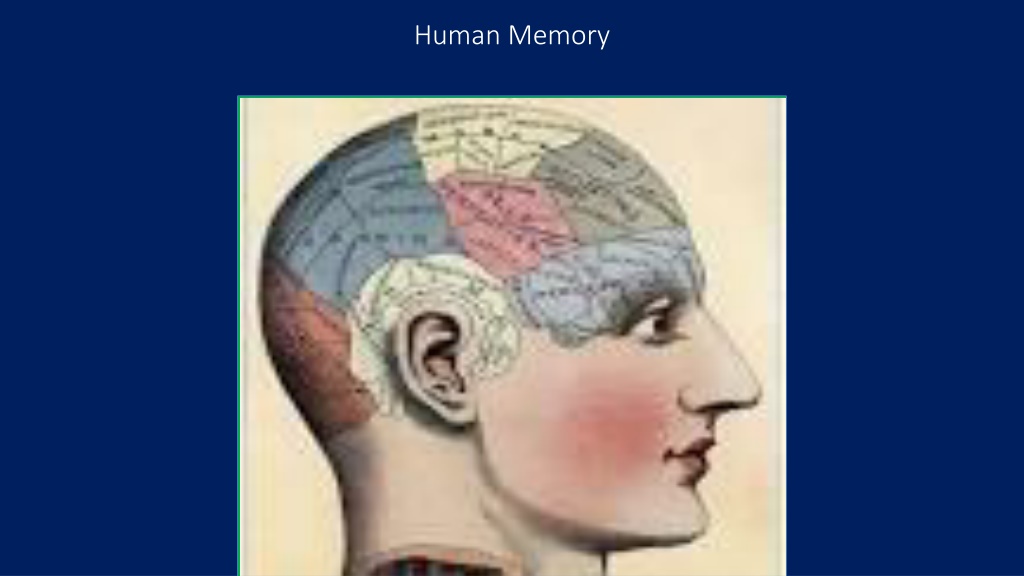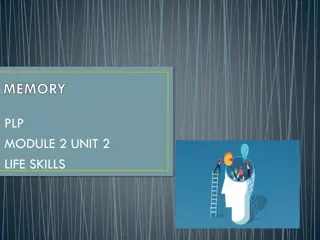Understanding the Three Stages of Human Memory Process
The human memory process is conceptualized as encoding, storage, and retrieval stages. Encoding involves registering new information, storage retains it for future use, and retrieval brings stored data to awareness. Explore how our memory system functions through these crucial stages.
Download Presentation

Please find below an Image/Link to download the presentation.
The content on the website is provided AS IS for your information and personal use only. It may not be sold, licensed, or shared on other websites without obtaining consent from the author. Download presentation by click this link. If you encounter any issues during the download, it is possible that the publisher has removed the file from their server.
E N D
Presentation Transcript
Nature of memory Unfamiliar telephone number vs remembering addition/substraction Memory conceptualized as a process 3 independent, interrelated stages ENCODING, STORAGE, RETRIEVAL
Encoding Process-information is recorded & registered for the first time so that it becomes usable by our memory system. -an external stimulus impinges on our sensory organs, it generates neural impulses. - are received in different areas of our brain for further processing. - encoding, incoming information is received and some meaning is derived. It is then represented in a way so that it can be processed further.
Storage - is the second stage of memory. encoded information must be stored so that it can be put to use later. -refers to the process through which information is retained and held over a period of time.
Retrieval - information can be used only when one is able to recover it from memory. - refers to bringing the stored information to awareness ;used for performing various cognitive tasks such as problem solving or decision-making. - failure to recall information ----- not encoded properly, or the storage was weak so could not access or retrieve it when required.
Information processing Approach Advent of computers- human memory information processing system Both register, store & manipulate large amount of information & act on the outcome of such manipulations
Stage Model proposed by Atkinson Shiffrin Elaborative rehearsals Attention Sensory Memory Iconic (Sight) Echoic (Sound) & other senses Short-term memory Store Capacity- small Long term Memory Permanent Store Capacity- Unlimited Information Store Capacity- large Duration-less than 30 seconds Duration-less than one second Duration- upto a lifetime
Sensory Memory Sensory Memory- -Sensory registers Sensory registers First entry of incoming information - sensory memory, large capacity. of very short duration, i.e. less than a second. -registers information from each of the senses with reasonable accuracy. Termed sensory register because information from all the senses are registered here as exact replica of the stimulus.
Sensory Memory Sensory Memory- - sensory registers. sensory registers. -iconic (visual) after-images (e.g.,. The trail of light that stays after the bulb is switched off) or -echoic (auditory) when you hear reverberations of a sound when the sound has ceased.
Short Short- -term Memory term Memory Information that is attended to enters the second memory store called the short-term memory (STM), which holds small amount of information for a brief period of time(usually for 30 seconds or less). Atkinson and Shiffrin propose that information in STM is primarily encoded acoustically, i.e. in terms of sound and unless rehearsed continuously, it may get lost from the STM in less than 30 seconds. STM is fragile but not as fragile as sensory registers where the information decays automatically in less than a second.
Types of long term memory contemporary view Declarative memory: all information pertaining to facts, names, dates, e.g.,. rickshaw has three wheels, India became independent on August 15 1947, a frog is an amphibian, you and your friend share the same name. Procedural memory: refers to memories relating to procedures for accomplishing various tasks & skills such as how to ride a bicycle, how to make tea or play basketball. Facts retained in the declarative memory are amenable to verbal descriptions while contents of procedural memory cannot be described easily. e.g. describing how cricket is played is easy but if someone asks you how do you ride a bicycle, you may find it difficult to narrate.
Declerative; Episodic & Semantic Episodic memory: biographical details of our lives, generally emotional in nature & the pleasant ones. e.g., your feelings when you stood first in the class Semantic memory: memory of general awareness & knowledge concepts, ideas & rules of logic-stored e.g., meaning of non violence, 2+6=8
Knowledge representation & organization in memory Knowledge representation & organization in memory- -LTM LTM Contents of long term memory get represented in terms of concepts, categories & images- organized hierarchically. Concepts: mental categories for objects & events, which are similar to each other in one or more than one way.
Schema Schema -mental frameworks which represent our knowledge & assumptions about the world
Hierarchical organization of long Hierarchical organization of long- -term memory term memory -knowledge is organized hierarchically & assumes a network structure -elements of this structure are called nodes. -connections between nodes are called labelled relationships, which indicate category membership or concept attributes.
Cognitive economy Cognitive economy -maximum & efficient use of the capacity of long-term memory with minimum redundancy.
Dual coding hypothesis Dual coding hypothesis All concrete objects generate images, knowledge related to them is encoded verbally & visually.
Memory as a constructive process Memory as a constructive process -using serial reproduction Bartlett found that participants altered the material given to them, elaborated the main theme -material more coherent & rational Bartlett explained this using the term Schema, active organization of past reactions & experiences.
Nature & causes of forgetting Nature & causes of forgetting Ebbinghaus s studies show that maximum forgetting takes place in the first 9 hrs. Not much is forgotten after that.
Forgetting due to trace decay Forgetting due to trace decay -memory leads to modifications in central nervous system called memory traces. -if disused they fade away, become unavailable
Forgetting due to interference Forgetting due to interference Memorising & learning produces associations. These sets compete for retrieval creating a process of interference. Associations Associations Retrieval Proactive & Retroactive
Forgetting due to retrieval failure. Forgetting due to retrieval failure. -at the time of recall the retrieval the cues are absent or inappropriate.
Enhancing Memory-mnemonics Robust dependable memory Images Strategies for improving memory-mnemonics Organization of learned information
Mnemonics using images Mnemonics using images Vivid, interacting images of the material, around the material-remember Bur Dubai Al Warka Turkey
Mnemonic devices-keyword method Spanish Pato English Pot
Mnemonic devices- method of loci Items to be remembered are placed as objects arranged in physical space- form of visual images Bread Eggs Tomatoes Soap
Example of trail Example of trail
Mnemonics using organisation Mnemonics using organisation Impose certain order on the material to be remembered. Framework created while organizing makes retrieval easy. Chunking: several smaller units are combined to form large chunks. Organisation principle for linking smaller units is necessary. FLOAT Figs Lettuce Oranges Apples Tomatoes
First letter technique First letter technique Strategies -too simplistic underestimate complexities of memory tasks & difficulties people experience while memorizing.
Engage in deep level processing Engage in deep level processing- -Craik Craik & & Lockart Lockart Processing information in terms of the meaning it conveys leads to better memory as compared to attending to only its surface features.
Minimise interference Minimise interference French- livre = book Spanish/Italian= Libro Avoid learning similar materials in a sequence. Study unrelated subject Give rest period to minimize interference.
Give yourself enough retrieval cues Give yourself enough retrieval cues Cues & links between cues help retrieval e.g. person should be in the same state during encoding & retrieval, Calm , well composed, attentive.
Thomas & Robinsons strategy Thomas & Robinson s strategy PQRST= Preview, Question, Read, Self-recitation & Test Single method cannot solve all problems of retention Attend to wide variety of factors; health, interest , motivation & familiarity with subject matter























